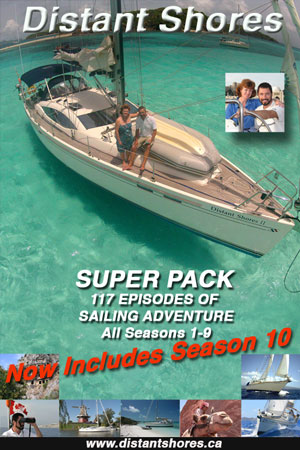Provisioning - Starting a Provisioning Notebook to Track Your Use of Supplies
By Sheryl Shard, copyright 2015. All rights reserved.
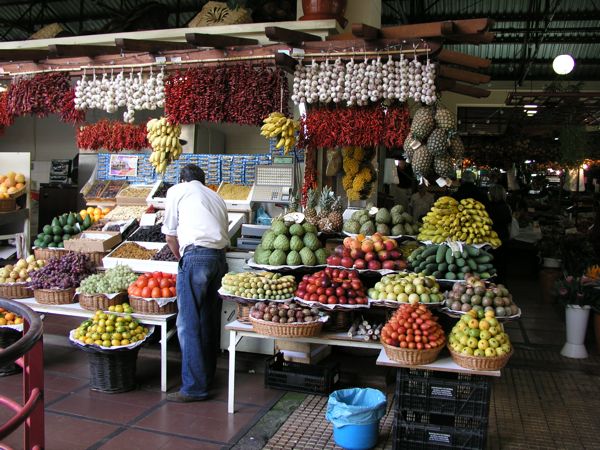
The delights of shopping in foreign markets.
The colourful market in the Portuguese island of Madeira.
Several months before our first major cruise in 1989, Paul and I started tracking our food and supply usage at home. This was the first step in designing a custom provisions list based on our individual needs and preferences.
We used a small three-ring binder with alphabetical index tabs which now contains complete and thorough lists of all our regular supplies. We entered items alphabetically in our binder every time we went grocery shopping and as we used things around the house and boat.
Over time, we developed a custom inventory of food items, cleaning and maintenance products, household goods and first aid supplies. We made notes beside each entry on how quickly we used things up, in what seasons we tended to eat more of certain foods and the changes in consumption rates of various products when guests stayed for a while.
This book is still our bible for provisioning. We consult it every time we go shopping to remind us of things we need. It is the foundation for our cruising inventory and provides reliable guidelines for how long we can cruise in isolation based on the supplies we have on board at the time.
Of course, when living aboard the boat, your regular eating habits and supply usage change somewhat due to factors such as the availability of certain products, your increased appetites due to physical activity and the galley equipment aboard your boat. However, we have found that our favourite foods at home are still the foundation of our provisions list for the boat.
As we travel, we discover new foods when we explore local markets and sample exotic cuisine in the ports we visit. In Spain, we developed a fondness for custard apples; in the Azores, two local women showed us how to prepare a delicious octopus stew; and in Brazil, a village boy introduced us to a refreshing bottled drink made from the fruit of the cashew tree. We make notes in our binder of any new “finds” and take them into consideration for future provisioning. I'm sure there is an app for this somewhere but my good old fashioned binder notebook that fits easily in my purse or backpack has served me well for years.
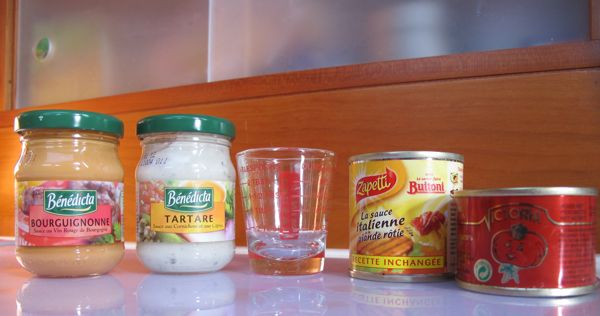
In France and the French islands of the Caribbean we discovered sauces in very small jars - handy when cooking for two.
Sometimes, we have to make substitutions or learn to live without products we enjoy at home when they are not available in the areas we are cruising. It was quite a shock to discover that peanut butter is only a staple in North America and difficult to find (or outrageously expensive) in most other countries. Now there is a big note in our provisioning binder to stock up on peanut butter when we’re going foreign!
We also take note of any changes we make in our regular routine while cruising. For example, we're real meat and potatoes people on shore but in many places around the world good meat is hard to find, expensive, or difficult to store. So when we are cruising, we are happier eating more stir-fries, stews and vegetarian meals (which are better for us anyway.)
Like many first-time cruisers, we initially made the mistake of loading the boat with canned goods we would never eat at home because books we had read said they stored well on a boat. If you don't eat canned corned beef or baked beans now, don't put them on the boat. Serving a crew food they hate will make them mutinous. On the other hand, nothing cheers up a wet miserable crew on a rainy night like a delicious meal of their favourite food or a surprise pack of a snack they love.
Building a list of food items and supplies you use regularly and annotating it with notes on how frequently you restock them, takes only a little time and starts you on the road to custom provisioning.
Go with What You Know
There are probably many things on your grocery list that you know how often to buy. For example, we know, without a doubt, that we go through 4 litres of milk every week whether living afloat or ashore. Start with the information that you know, and build from there. Any items you are uncertain about, make a point to observe and record your consumption rate in your provisioning notebook.
Of course, if you are planning a short-term cruise or cruising in an area where shopping is easy, you won’t need such in-depth records to plan your meals. But the longer and further you travel, the more helpful this kind of detailed information becomes.
When Paul and I were building our first boat, Two-Step, and our Atlantic cruise was a far-off dream, designing our stores list became an uplifting project after busy day's work. We'd quickly forget the stresses at the office as we added items to our provisioning binder and discussed the supplies we'd need for an ocean passage or a winter in the tropics.
Fuel your imagination as you create a master list of foods and supplies important to you!
Creating Your Own Provisioning Binder, Notebook or Spreadsheet
A good way to begin a custom provisions list for your cruise is to set up a binder, notebook or spreadsheet to record the supplies you use regularly. (There may even be an app for this that I haven't discovered yet. If you've found one you use, please let me know.)
Whenever you shop for food, household items or marine supplies, add the items to your book so you will have a master list of the common supplies you depend on.
The next step is to record the rate at which you consume them. This way, you will know how long things will last during your voyage and how often you will need to replace them.
A laundry marker and masking tape are useful tools to help you record the consumption rate of each item on your master list. Whenever you open a new tube of toothpaste, write that day's date on it with the laundry marker. When it's all used up, record the number of weeks it took to finish it.
Repeat the process a few times to get an average. For items that you can't or don't want to write on, such as paper towels, write the date on a piece of masking tape and stick it inside a nearby cupboard door.
Every couple of weeks, go through a cupboard in your kitchen, storage room, or the lockers in your boat to remind yourself of items that you don't buy regularly but like to have on hand. Certain spices, soup mixes, and cleaning products fit into this category for us. Add them to your lists and estimate how often you'll have to replace them if you are planning a long-term cruise.
These records are invaluable when provisioning for your cruise since they reflect your personal needs and preferences.
Check out more articles on Provisioning here.
Join our email list and get hints, technical articles and tips plus videos to help you achieve your cruising dreams.
- FREE 1/2 hour video on cruising the Exuma Islands in the Bahamas
- Technical Blog shows you how to deal with issues facing the cruising sailor
- Destination information from some of the world's best cruising areas
- Special discounts and promotions
St. Maarten - Locker Clear-out and Inventory
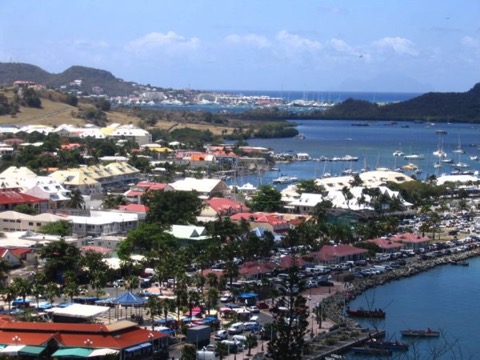
Simpson Bay Lagoon
For the last couple of weeks Paul and I have been aboard Distant Shores II anchored in the protected waters of Simpson Bay Lagoon on the Dutch side of the island of St. Maarten/St. Martin. This island is unique in that half the island is Dutch and the other side belongs to France!
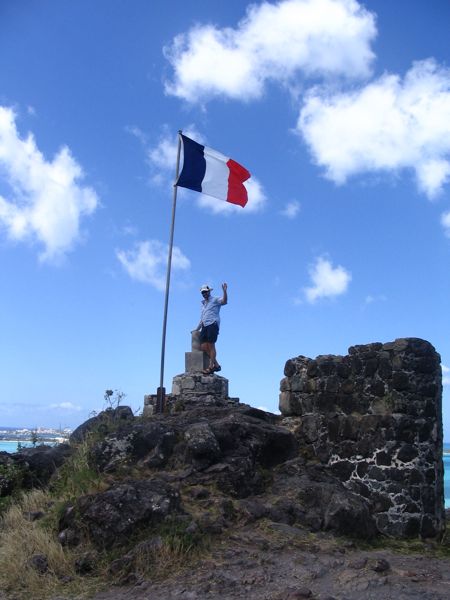
Paul and French flag at Fort Louis, St. Martin
It is also a major yachting centre and duty free port which for sailors means it's a great place to stop to do boat projects, repairs, and annual maintenance; stock up the boat with food and goods from around the world at affordable prices; top up the fuel tank and enjoy the camaraderie of fellow sailors.
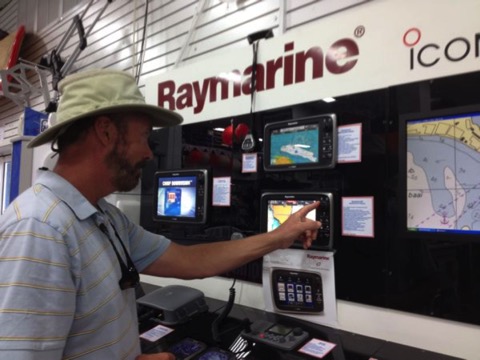
Paul checking out the latest Raymarine equipment at Budget Marine, one of the major chandleries in St. Maarten
See my newsletter from our last visit, “Leaving St. Maarten” - 05/06/13. The island is a “cruisers crossroad” and you are bound to meet up with sailors you have met elsewhere on your travels. It's also a jumping off spot for sailors heading up or down island, offshore to Bermuda or Panama or across the Atlantic to Europe.
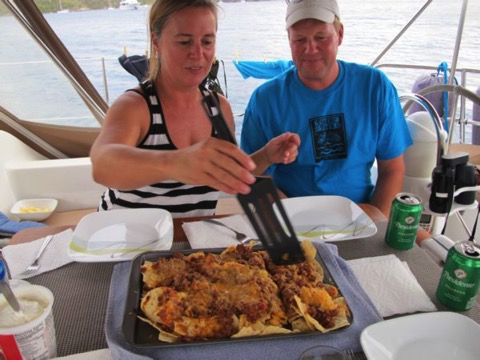
Dinner on board SV Banyan with cruising friends, Alex and Dave.
Like most of the crews on the boats anchored around us, we're taking the opportunity to do a little spring cleaning before the next leg of our voyage. Paul and I try to empty, inventory and clean out every locker on the boat at least once a year and St. Maarten is a good place to do it since here we have access to just about everything that we might need to replace, upgrade, repair or re-stock on our Southerly 49 sailboat. Our plans for this spring include time in the out-islands of the Bahamas where self-sufficiency will be key.
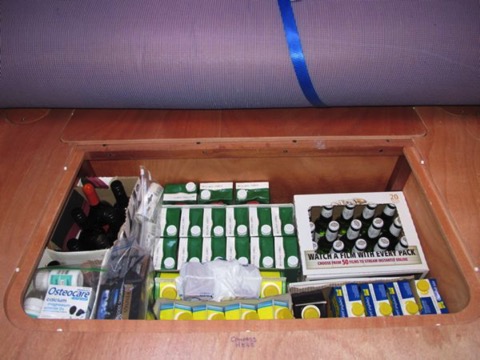
Before loading your boat with provisions and spares, we find that doing a thorough locker clear-out and cleaning helps you to rid yourself of unnecessary clutter to make room for the fresh supplies coming on board. It also helps to remind you of the stores you have so you don't purchase things already on the boat. It's surprisingly easy to forget what's on board despite valiant attempts at updating your inventory lists. Things do settle to the bottom of lockers and erase themselves from your memory or fall off lists.
Checking lockers regularly means that “disasters” such as exploded soft drink cans or cracked ketchup bottles don't go undetected. It is really depressing to return to the boat exhausted from shopping and find a locker you are about to fill with groceries is in an awful mess.
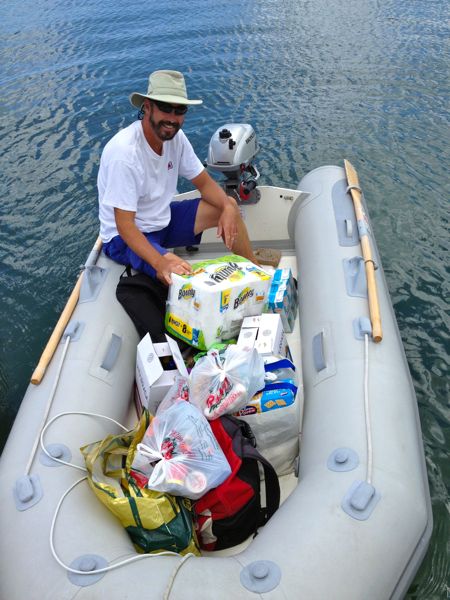
But most important of all is that this is a great time to examine how well you are using the storage space available on your boat and to make changes while the boat is relatively empty. Organizing the boat in a way that is convenient for you and that achieves your goals makes it a nicer place to be. If you like cruising in remote places you'll make carrying lots of supplies a priority for your storage areas versus a crew that loves performance sailing who would keep the boat light and makes sail storage a priority. The more efficiently you use your boat's storage space, the more money you'll save, the better your boat will perform, the more comfortable you'll be and the better sense of control you will have in your cruising life. Sometimes it will seem to be the only thing in control! LOL.
A Few Tips on Efficient Organization of Lockers:
1.Store items near their point of use.
2.Analyze your storage spaces and determine their degree of accessibility. Items you use regularly should be stowed in the most accessible cupboards and lockers. To determine the best use for each locker or cupboard, think about what you're most likely to be doing when you’re standing near it or where you’re going when you walk by it.
3.Consider the importance of weight distribution. Keep heavy items like canned goods low down and lighter items like pasta in higher cupboards. Similarly store heavy items centrally and keep the ends of the boat light so she can sail well and respond to the seas. Weight in the ends causes most boats to bury their bows in the waves.
You Might also like the following...
Tropical Storm Chantal Arrives
Making Money While Cruising
Maintaining a Homebase
About the Southerly 49
Top 10 Canal Journeys
Martinique - After the Storm
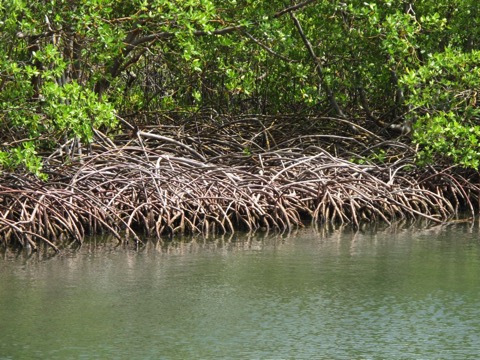
In my last newsletter we had been cruising on the south and east coasts of Martinique when we got word that Tropical Storm Chantal was headed in our direction. I referred you to several detailed reports that Paul wrote for his Tech Blog about how we prepared and fared, and this week he has posted another one for you, Tropical Storm Moves Off, about the aftermath of the storm which I also invite you to read.
Housekeeping after Tropical Storm Chantal
Tropical Storm Chantal blew through by lunchtime on July 9/13 and everyone anchored in the mangrove gave a sigh of relief and basically just rested for the afternoon (unless they had damage to contend with which fortunately we didn’t). You experience a big adrenaline crash after dealing with situations like this. Then we got really hungry!
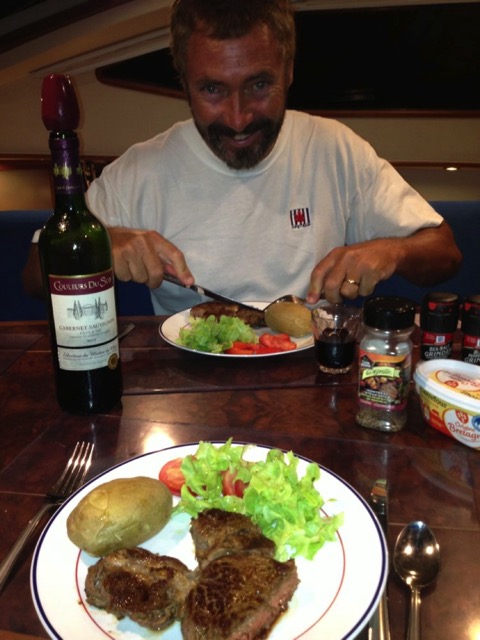
We felt like celebrating so Paul jumped in the dinghy and came back from town with steaks and a bottle of French wine. We slept well that night.
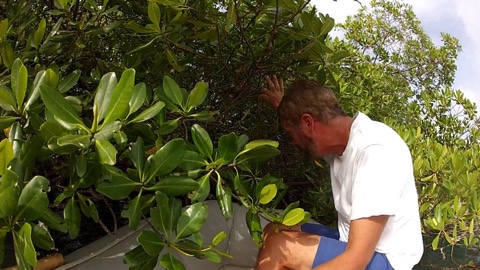
The next morning was spent untying the spiderweb of lines we had tied onto the mangrove roots.
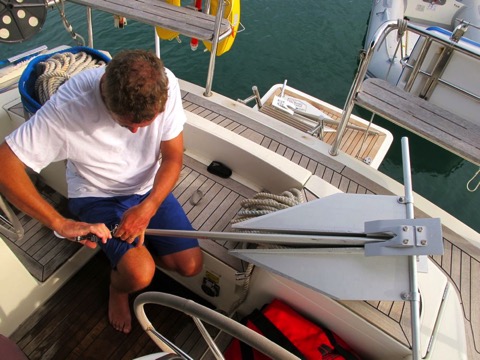
Then we had 3 anchors to raise - our 33kg Rocna anchor, a Fortress FX37 and Fortress FX23. They were really hard to get up (a good thing!) now that they were firmly wedged into the muddy sand bottom of the lagoon after taking the force of the 50-60 kt winds during the tropical storm.
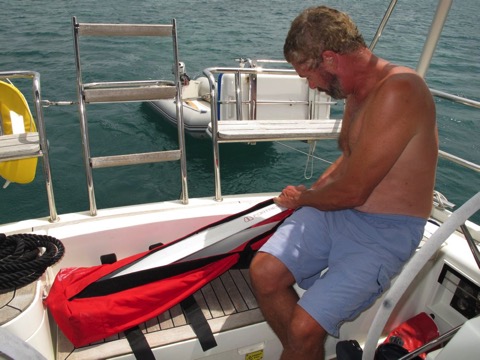
The Fortress anchors make excellent secondary anchors since they are aluminum so strong but lightweight and stow compactly in canvas bags which are easy to carry. The additional anchor rodes we keep coiled, clean and dry in canvas bags in a large sail/fender locker in the bow of the boat.
Health Issues
Now that the storm had passed and we had no damage or injuries, my main concern now was a health and safety issue. In the Caribbean islands you are vulnerable to catching dengue fever and dengue hemorrhagic fever (sometimes fatal) which are viral diseases transmitted by aedes aeypti, a domestic day-biting mosquito.
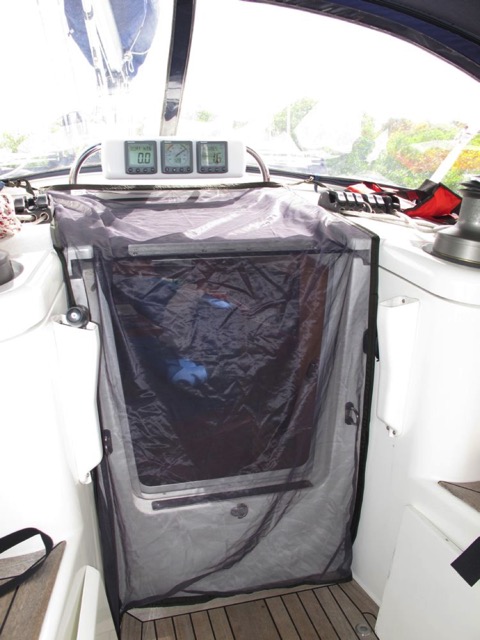
Mosquito net covering companionway hatch aboard Distant Shores II. Photo by Sheryl Shard
Despite precautions (tropical strength insect repellent with deet and screens/mosquito nets on the boat) we both had gotten a lot of mosquito bites crawling around the mangroves in the heat.
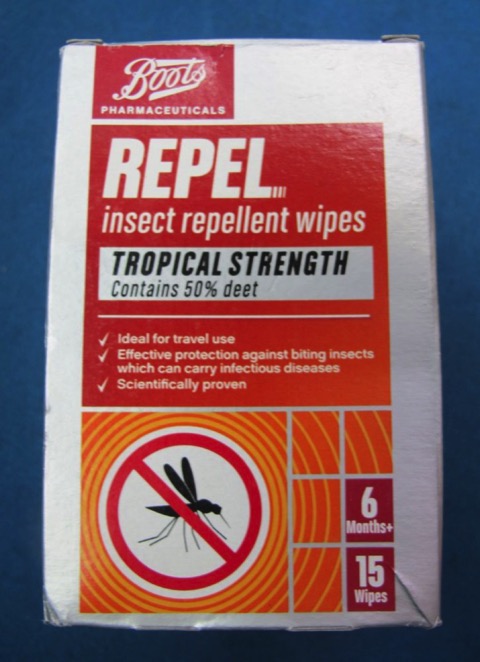
Be sure to keep a supply of tropical strength insect repellent containing deet on board when cruising in the Caribbean.
Symptoms of dengue fever occur after a 2-7 day incubation period and may include high fever, severe headache, joint and muscle pain. If you suffer from any of these symptoms a few days after getting bitten don't take aspirin (there is a risk of bleeding) and see a doctor immediately. So I was watching us both for symptoms and am happy to say that all is well!
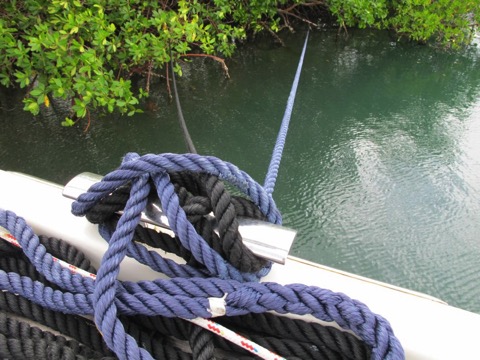
Another issue I hadn't even thought about was the risk of rats coming on board by crawling up the lines we had tied into the mangroves! Some local sailors ,who spend the summer working in Marin and leave their boat tied into the mangroves all the time, mentioned this to us later. Our friends cut out the bottom of large water bottles and thread them into the lines they tie ashore so that if rats do come up the lines they can't get past the scoop made by the water bottles. I've heard of people threading metal pie plates into their dock lines to create barriers to crawling creatures as well. You see fancy versions of this on cruise ships. I'm happy to report that we had no stow-aways after being in the mangroves! I'm glad I didn't know about this concern at the time. I'd have been awake all night!
Marin
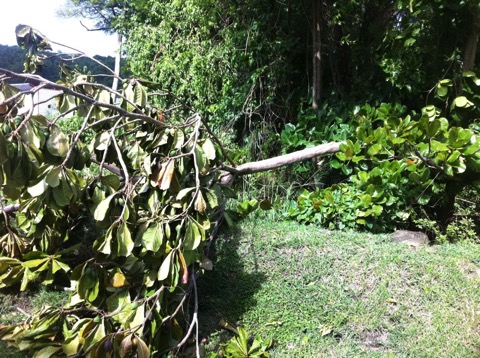
Once untied, we headed back out into the fresh air and open space of the main harbour of Marin. Boats here didn't fare as well during the storm since anchors broke loose and the drifting boats created a domino effect by bouncing into other boats and fouling their anchors, setting them adrift as well. Lots of trees were down ashore too.
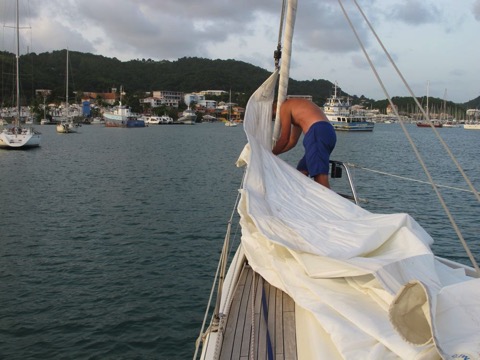
Order had now been restored and finding a clear spot in the anchorage we started putting the sails back up and preparing to head south to St. Lucia.
Communications
In Marin there is bay-wide high speed internet available from the Marin Marina. You buy vouchers for several hours, days or months from the main office (they speak English) so we were well connected in Marin. We could do uploads to our website and make skype phone calls without difficulty. There are also lots of internet cafes around town.
Provisioning
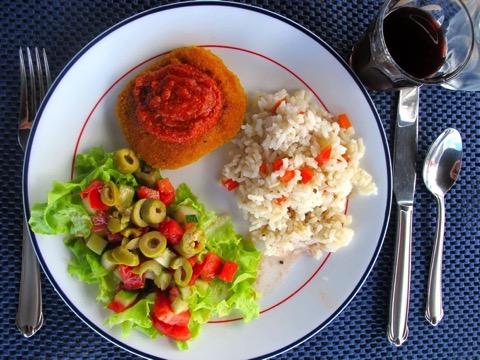
Before leaving Marin I wanted to do some more stocking up. Martinque is a French island so was a good place to add to our stock of good French wine, cheeses, and specialty European products that I had discovered when we cruised through the French canals last summer.
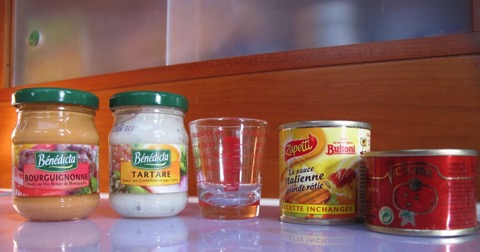
An example was little tiny jars or cans of delicious sauces perfect for 1 meal for 2 people on a sail boat. These are not exactly environmental but store well and can make a meal at sea on a passage a real treat and you don't have to deal with ½ a can of tomato sauce in a rolling boat. (I do stock large cans as well and store unused portions in Lock 'n Lock™ plastic containers when we're at anchor or just coastal cruising.)
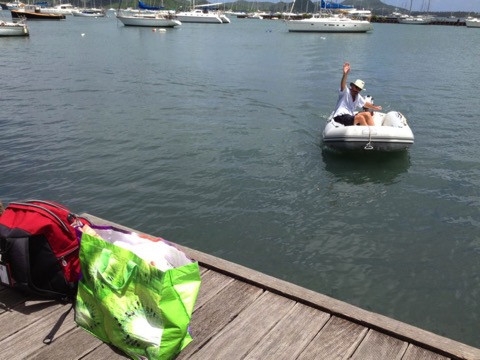
There are several good grocery stores in Marin with nearby dinghy docks – Carrefoure, and 2 discount grocery stores called Leader Price and Dia which are good for stocking up on beverages, snacks and dry goods. Their meat and produce were pretty good too but I found Carrefoure to be the best since it had more selection.
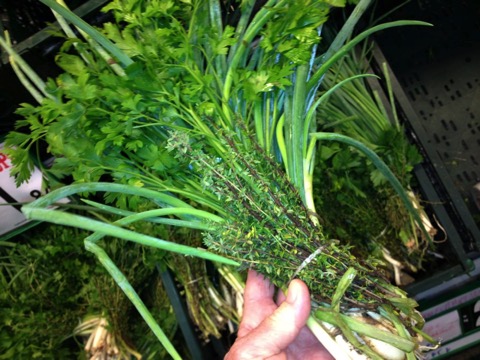
In the grocery stores in Martinique you can buy herb bundles (bouquet garni). Here is a bundle of thyme, parsley and green onions.
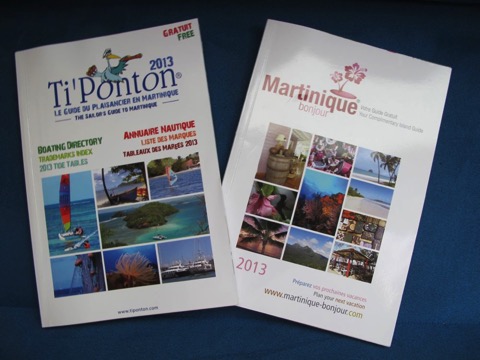
Marin is a huge base for many yacht charter companies so there are all kinds of specialty food stores and provisioning services here as well. All are listed in the free guide “Ti'Ponton: The Sailor's Guide to Martinque” as well as all yacht services and chandleries. You can pick it up many places in town including the marina. It is written in English and French. Another useful free guide is “Martinique Bonjour” with tourist information. The section on Martinique in Chris Doyle's, Sailors Guide to the Windward Islands, the cruising guide we have been using, also lists provisioning options plus yacht services and chandleries. Chris also gives sketch charts showing the dinghy docks closest these facilities.
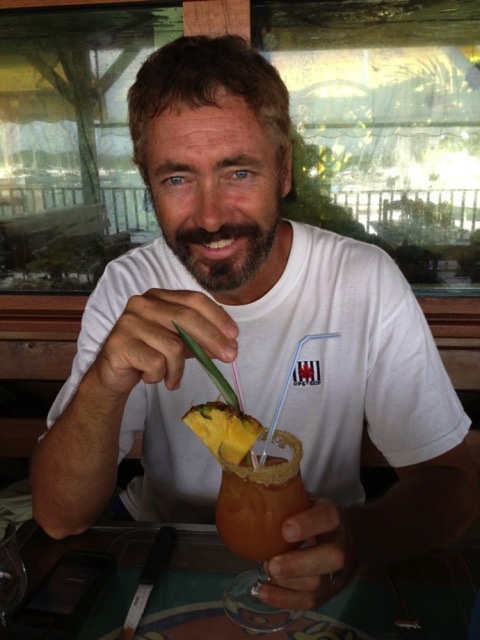
Once our chores were done and provisions stored we decided once again to celebrate our safe handling of Tropical Storm Chantal this time with lunch ashore at Mango Bay Restaurant and Bar, a waterfront place local friends had recommended.
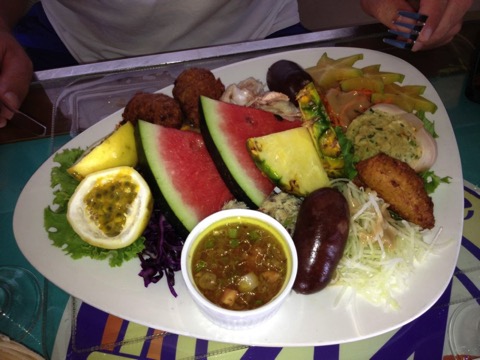
Fruity cocktails and a sampler plate of local goodies was the order of the day.
Clearing Out from Martinique
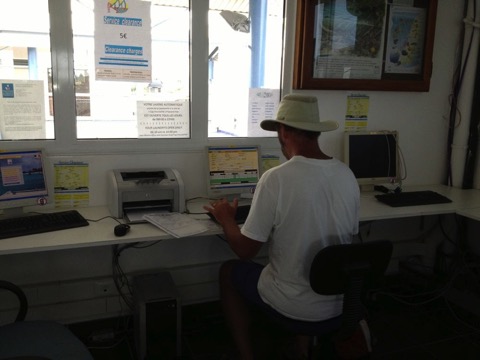
Next we went to clear out from Martinique so that we could leave early the next morning on July 12 for St. Lucia. This was done at a do-it-yourself Customs and Immigrations computer located in the marina office in Marin. There is a 5 euro administrative charge. The marina receptionist checks your papers and stamps your printed clearance papers once you have filled in the details. Although convenient, the process can be slightly challenging since form is in French and you are working with an AZERTY keyboard used on computers in French territories so letters are in different places on the keyboard. For information on Customs and Immigration for Martinique click here.
We had arrived in Martinique on June 16th in St. Pierre. What a wonderful, and rather exciting, 3 ½ week cruise around this French island in the Caribbean!
More News
DS episodes - Atlantic Rally for Cruisers (ARC)
We've just completed post-production on 2 new episodes of Distant Shores about cruising in the Canary Islands and our transatlantic passage as participants in the Atlantic Rally for Cruisers (ARC). These episodes are the first 2 of 3 episodes covering the ARC, all part of Season 9. The “Distant Shores Season 9 DVD - France, Morocco and the Atlantic Rally for Cruisers” will be available in August 2013. However individual episodes are available now online as HD digital downloads on Vimeo.
Port Credit In-Water Boat Show August 23-25, 2013
We'll be flying to Canada at the end of August to conduct seminars about “A Summer Cruise through the French Canals” at the Port Credit In-water Boat Show, Mississauga (near Toronto), Canada.
Friday August 23 at 1:30 - 2:30 p.m.
Saturday August 24 at 3:00 – 4:00 p.m.
Sunday August 25 at 3:00 – 4:00 p.m.
Information and directions here
That's it for this week...
Wishing you Fair Winds,
Sheryl and Paul
Aboard SY Distant Shores II
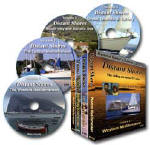
Click here to check out our DVDs for more cruising adventures and tips!
Distant Shores TV Show Facebook
Distant Shores TV Show Twitter
Departing St Maarten
I, Sheryl, just got back to the boat after a 2-week visit home to Canada for some business meetings and to catch up with family and friends. Paul stayed on board Distant Shores II anchored in Simpson Bay Lagoon working on scripts and rough-editing 2 new episodes of the Distant Shores sailing adventure TV series while I was away. Paul and I have been married for 27 years and this is the longest we’ve ever been apart! Thank goodness for skype and facetime so we could make video calls :-) We had dinner together via skype a few times and whenever I was at a gathering of friends and family we would call up Paul on skype and pass him around. Isn’t technology marvellous!
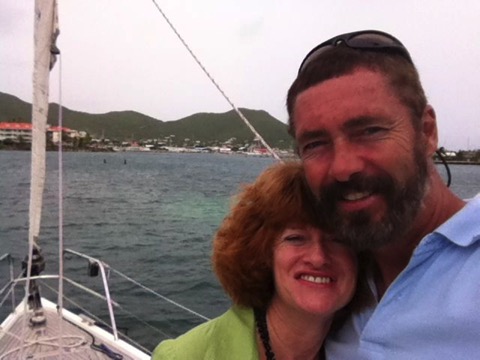
I flew back to St Maarten from Toronto yesterday and Paul met me at the airport and then treated me to lunch at the St Maarten Yacht Club. I had a great time at home but it was so good to be back on board Distant Shores II with Paul.
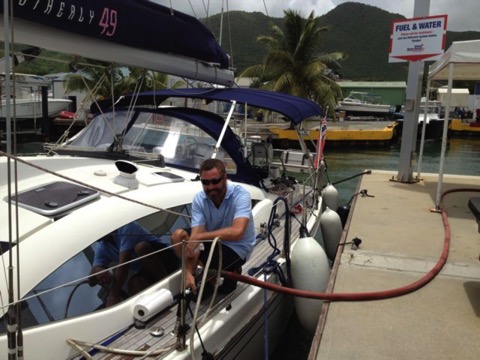
Today was a day of chores. First thing this morning we raised anchor and headed for the fuel dock at Island Water World to top up the fuel and water in preparation to sail to St Kitts and Nevis tomorrow and then continue down-island. IWW generally has the best price on fuel in St Maarten. Today diesel was $1,18 US/litre and water 15¢ per US gallon. If you pay by credit card there is an extra 4% surcharge.
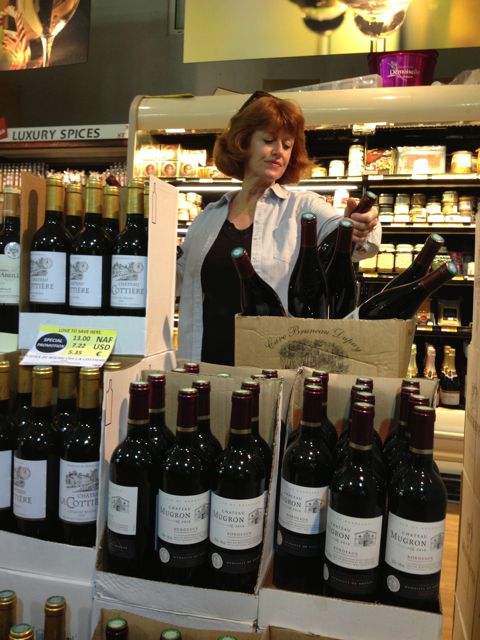
Next on the list was stocking up on provisions. We like to shop at Le Grand Marche in St Maarten. We can take the dinghy to the dinghy dock at Port de Plaisance Marina and walk up from there. There's a very nice selection of European delicacies & wines at good prices since the island is duty-free. For even cheaper prices there is a Cost U Less (similar to Costco or Sam's Club) a bus or taxi ride away but Le Grand Marche is convenient. They give a 5% discount if you're doing a large purchase for the boat and offer free delivery in the store's van to the dinghy dock. We give a few dollars tip the driver who usually helps carry stuff from the quay down the dinghy dock.
As I write to you now, Paul is at Customs and Immigration clearing us out to leave first thing tomorrow morning. I’m on board stowing provisions. I’m protecting the wine bottles in clean socks to prevent breakage. I also group similar items and put them in self-sealing plastic bags. This makes it easier to find things and if anything breaks or leaks, the mess is pretty much contained in the plastic bag.
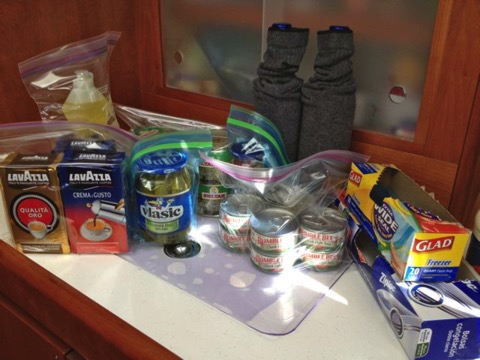
Everything is stowed under in lockers around the boat. Under the bed, under the settees, wherever there is space.
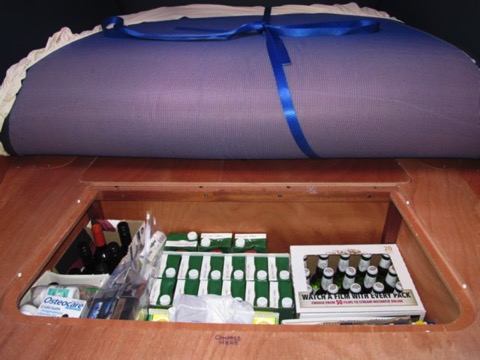
We came out of Simpson Bay Lagoon through the Simpson Bay Bridge at the 4:30 p.m. bridge opening. The opening at 4:30 pm is for outgoing vessels and at 5:30 p.m. it opens for incoming vessels. We are now anchored in Simpson Bay ready to sail off tomorrow morning, all going well.
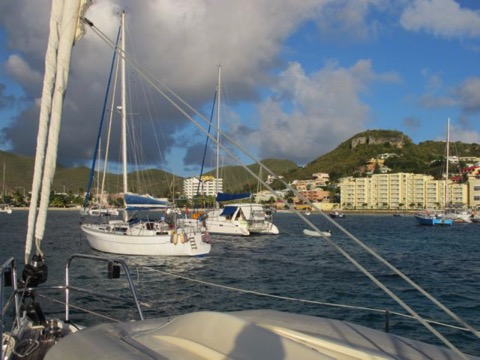
We may be out of touch for a couple of days as we island-hop south but will post again as soon as possible.
We’ll be in touch again soon!
Warm regards,
Sheryl and Paul
Aboard Distant Shores II
St Martin to British Virgin Islands
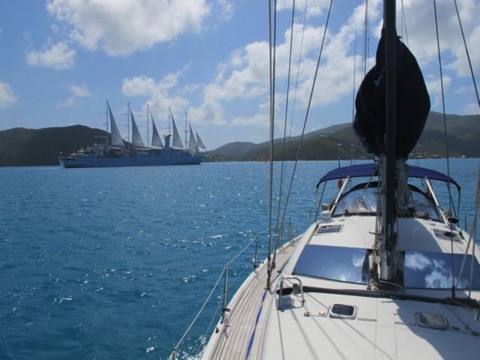
Greetings from the British Virgin Islands!
Our first visit here was in 1985 when Paul and I chartered a CS 36 sailboat with friends to test out our dream of sailing to the tropics. Needless to say, we loved it and did the voyage from Toronto, Canada, on our own boat a few years later. A lifestyle of sailing adventure began and our work as travel documentary filmmakers and writers blossomed. Now, with over 20 years of years of international cruising experience, 90,000 miles of voyages on our sailing resumes, and over 100 X 30-minute episodes of our sailing adventure TV series Distant Shores being broadcast around the world in 24 languages, we are back in the British Virgin Islands(BVI) for probably our 10th visit.
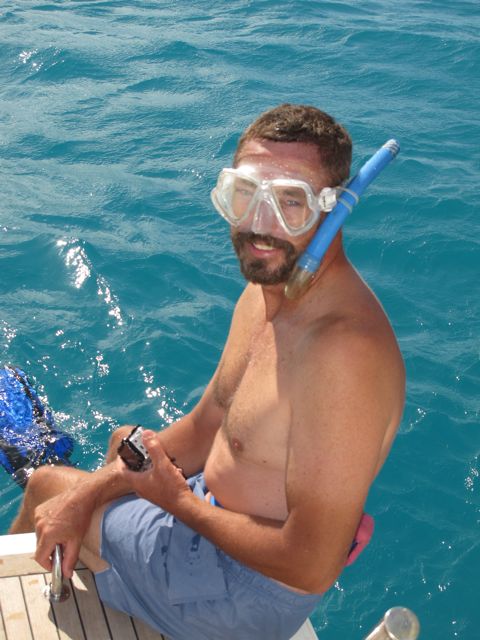
This time we're cruising this beautiful island chain on our 3rd boat, Distant Shores II, a Southerly 49 variable-draft sailboat, which we sailed across the Atlantic Ocean last December as participants in the ARC (Atlantic Rally for Cruisers). We were accompanied by our ever-cheerful Australian friend, Matthew Heron, who is an excellent sailor and, as always, great crew for a passage. It was Paul and my 5th transatlantic crossing and we documented the experience for Distant Shores episode #111 which is still in post-production.
To see a Sneak Peek from this episode about how we dealt with squalls on the transatlantic passage Click Here.
When I last wrote to you, on February 15, we had just re-launched Distant Shores after a couple of weeks of annual maintenance on the French/Dutch island of St Martin/St Maarten. We spent a couple of days at anchor in Simpson Bay Lagoon finishing up projects and then did a big grocery run across the lagoon in our dinghy to stock up on European delicacies and duty free goods for the ship's stores before leaving for the BVI where things can be a bit more pricey although there is great selection.
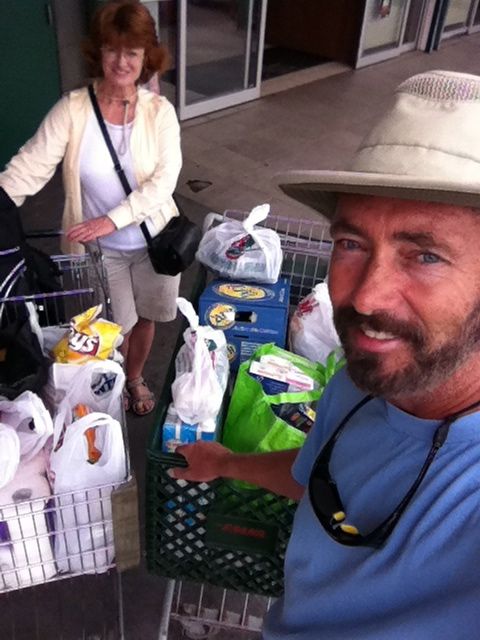
We got rather enthusiastic and when the courtesy delivery van from Grand Marche deposited us at the dinghy dock at Port de Plaisance, we had so much stuff we were afraid we were going to sink the dinghy on the ride back to the boat! Luckily it was a calm day and by going very slowly we arrived safely back at Distant Shores II without losing any of our cargo.
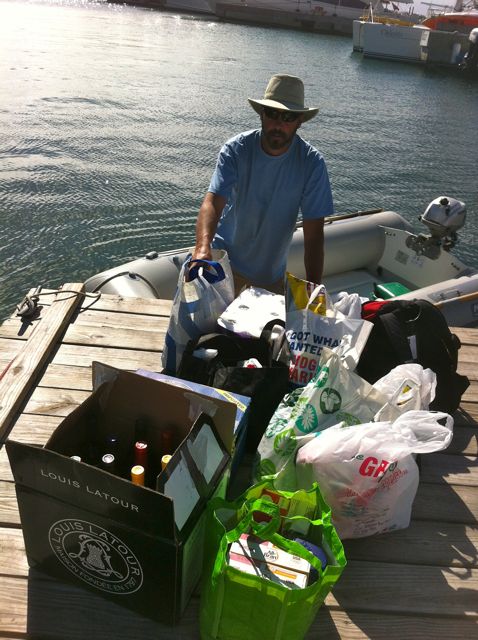
The next day when everything was carefully stowed away in lockers under benches and berths, we headed out of Simpson's Bay Lagoon at the 5:30 p.m. bridge opening at Sandy Ground Bridge on the French side of St Martin. (Sandy Ground Bridge Openings are at 8:15 a.m, 2:30 p.m. except on Sundays, and 5:30 p.m. Outbound traffic before Inbound. Bridge Operator is on VHF Ch 16 or tel. (0590) 590 87 20 43. There are no bridge fees as there are on the bridge on the Dutch side.)
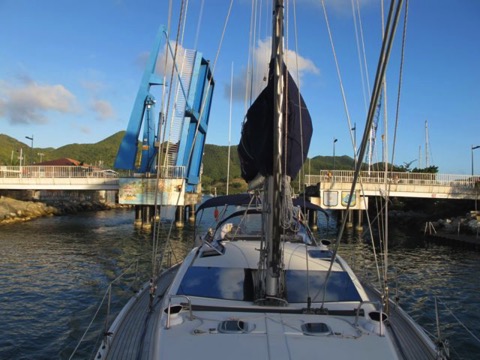
Conditions were good for anchoring off the town of Marigot in Marigot Bay. If there is a big swell from northerly directions it can be very rolly but we had steady east winds. Out in the clear open water off Marigot you can swim off the boat and beaches (the water in the lagoon is too dirty for swimming unfortunately) which was the first thing we did when we were anchored in Marigot Bay. This was followed by a sundowner in the cockpit looking at the lovely view of the town with Fort Louis overlooking all.
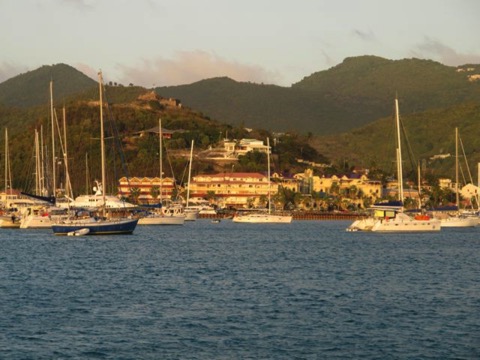
Paul and I try not to work on a Sunday and honour it as a day for family and friends so in the morning we took the dinghy back to St Maarten Shipyard and visited friends Peter, Monika, and their daughter, Claudia, aboard their boat, Tauá. We’d met Peter when working in the yard. His wife and daughter had just arrived from Paris and we were looking forward to meeting them. Like Peter, Monika and Claudia were great company and we ended up taking the bus into town together (you just hail little vans that have a BUS license plate as they pass by. $1 per person) to enjoy Sunday Brunch with them at ZeeBest Restaurant near the Simpson Bay Marina.
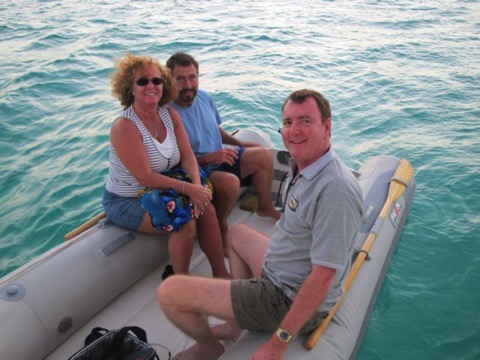
In the afternoon, Paul met up with long-time friends from our York University days, Terry Fraser and Michele Yard Fraser, who he picked up in the dinghy at the Marigot waterfront. Terry and Michele have had a timeshare in St Maarten for many years and know the island well. We had a great afternoon together aboard Distant Shores II and got caught up on everyone's news and adventures.
Back in Marigot Paul cleared us out from St. Martin (you can clear Customs and Immigration on Sundays at Marina Fort Louis, otherwise at the ferry dock or the harbourmasters office at Marina Port La Royale the rest of the week). We were planning to leave early the next morning for the British Virgin Islands.
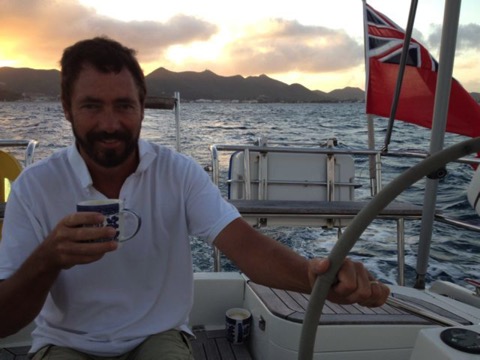
Morning commute aboard Distant Shores II
At 0630 on Monday February 18, we raised anchor and began a 84-mile crossing of the Anegada Passage, a strait that lies between the British Virgin Islands and St Martin plus the neighbouring island of Anguilla.
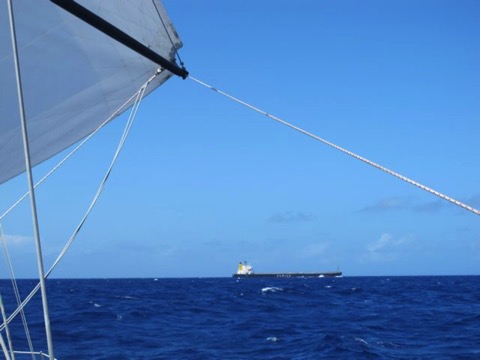
Many large ships enter the Caribbean Sea through this strait so we kept our eyes peeled and throughout the day we saw a lot of them. We had beautiful fresh tradewinds blowing from behind us so we poled out our jib and genoa and sailed wing and wing for the day.
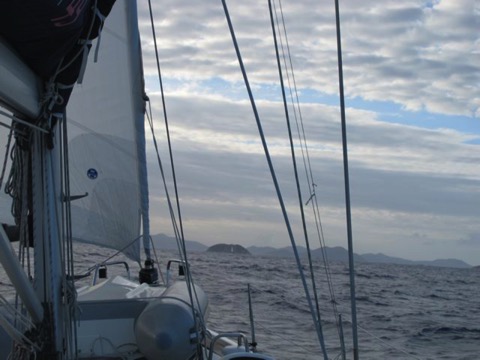
After a great sail, we arrived at Round Rock Passage in the British Virgin Islands 12 hours later, just before sunset so the timing was perfect. From there we made a 20 minute run up to Spanish Town where we anchored for the night. First thing the next morning we cleared-in to the British Virgin Islands at the customs office at Spanish Town ferry dock on Virgin Gorda. Customs offices are open Monday to Friday 8:30am to 4:30pm and Saturday 8:30am to 12:30pm. Closed Sundays and on BVI public holidays. For more info on locations and cruising permit fees Click Here.
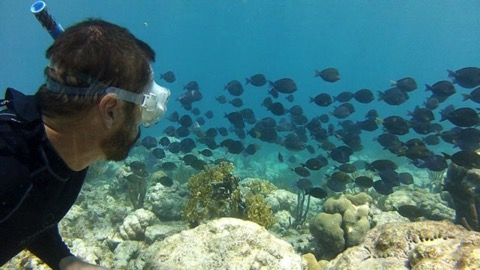
Paul and school of Blue Tangs
We will spend the next couple of weeks break here in the BVI, relaxing at anchor, snorkelling, and working on scripts and editing. We have already filmed 2 episodes of Distant Shores about the BVI, one about bareboat chartering here if that is something that interests you. You can see both BVI episodes in the Distant Shores season 5 DVD collection. For more information or to watch a trailer Click Here.
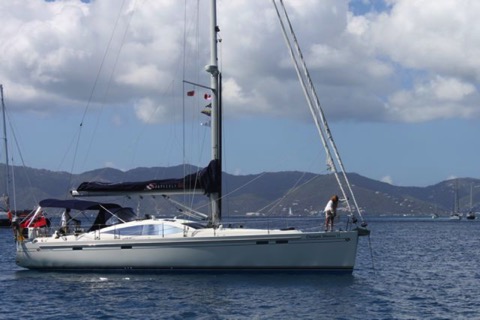
Anchoring in Great Harbour, Peter Island. Photo by Andrew Evans
At the moment, Distant Shores II is anchored in Great Harbour, Peter Island, one of our favourite places for snorkelling. The sun is high so it's a good time to go for a dip and explore the reefs along the shore, so we'll say ciao for now.
Have a great week!
Sheryl and Paul
Aboard Distant Shores II
Great Harbour, Peter Island
British Virgin Islands
Researching Destinations for your Dream Cruise?
Check out the entire Distant Shores Super Pack which now includes the newest episodes in the Caribbean, Turks & Caicos and Bahamas from Season 10.
